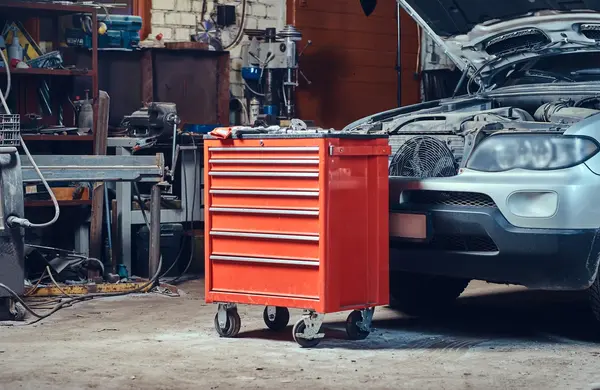Garage
How to Set Up the Ultimate Starter Mechanic’s Garage

Not a millionaire? Not a problem. You can still build the perfect mechanic’s garage for wrenching.
One of the hardest realities of being a DIY wrencher is knowing you’ll likely never have the kind of high-tech shop seen on TV. Those celebrity garages are equipped to churn out dream builds in weeks, not years. But does that mean you need a massive space packed with expensive gear to get serious work done? Absolutely not.
Some of the most incredible builds come from a humble two-car garage—or even a driveway. As long as you have the right tools and an organized system, any project is possible, no matter the space.
Building the Perfect Garage: The Basics
- Estimated Time Needed: Ongoing
- Skill Level: Beginner
What Makes the Perfect Garage?
The ideal garage isn’t about size or luxury—it’s about efficiency. The goal is to create a workspace that keeps you in a steady workflow from start to finish without frustration from clutter or disorganization.
Since every mechanic has different needs, the best approach is to start small and refine your setup as your skills and projects evolve. Even with an unlimited budget, building the perfect garage takes time and experience.
Garage Safety Considerations
While we’re not talking about constructing a garage from the ground up, safety is still a top priority when setting up your workspace. Keep these tips in mind:
- Store chemicals safely. Flammable and toxic substances should be kept in a dedicated chemical storage cabinet.
- Don’t overload shelving. Be mindful of weight limits to avoid collapses and injuries.
- Keep heavy items low. Store large parts like cylinder heads on the ground to prevent dangerous falls.
- Secure sharp objects. Organize tools so that pointed or sharp ends face away from where you move.
Essential Tools & Equipment
While every garage setup is unique, there are some universal must-haves:
Tool & Equipment List:
- Toolboxes
- Tool chest
- Mechanic’s toolset
- Workbench
- Shelving units
- Small parts organizers
- Push broom
- Shop vac
- Magnetic sweeper
- Storage cabinets
- Air compressor
- Pneumatic tools
- Floor jack
- Jack stands
Organizing your tools efficiently will save time and frustration—especially when you’re in the middle of a project and need something fast.
Steps to Setting Up Your Garage
1. Clean & Prepare the Space
Before installing shelves and benches, start with a thorough cleaning. Sweep the floors, wipe down walls, and remove unnecessary clutter.
2. Take Inventory & Gather Essentials
Compare what you already have to the must-have list above. If you’re missing items, prioritize purchases based on your immediate needs and budget.
3. Start Wrenching
Test out your space by taking on small projects. This will help you understand what setup works best for your workflow.
4. Reorganize & Optimize
After a few projects, take note of what’s working and what isn’t. Adjust tool placement, workbench arrangements, and shelving systems to improve efficiency.
5. Invest in Extra Tools & Accessories
Once your workflow is optimized, consider adding items like:
- Magnetic tool rails
- Paper towel dispensers
- Screwdriver holders
6. Keep Your Space Clean
Regular cleaning prevents tools from being misplaced and reduces unnecessary spending on replacements.
7. Build a Parts Inventory
Keep spare parts organized on labeled shelving. This will save money in the long run by reducing repeat purchases.
Planning the Dream Garage Setup
If starting from scratch, here’s how to build an efficient workspace:
Space Considerations
A two- or three-bay garage is ideal for dedicated project areas. If space is limited, maximize vertical storage with shelves and pegboards.
Workbenches & Tool Storage
- A wrap-around workbench provides plenty of surface area for projects.
- Pegboards keep frequently used tools within reach.
- Large tool chests store specialty tools like electrical testers and pneumatic tools.
Parts Storage
- Multi-tier wire rack shelving keeps parts accessible and organized.
- Totes and bins prevent clutter and allow easy part retrieval.
Specialty Equipment
- A 30-gallon air compressor supports pneumatic tools and painting projects.
- A transmission jack simplifies clutch and gearbox work.
Lift or No Lift?
If budget and space allow, a car lift is a game-changer. Otherwise, a solid floor jack, jack stands, and a creeper will do just fine.
Pro Tips for Building the Perfect Garage
- Learn from other shops. Observe how professionals organize their tools and workflow.
- Test before you invest. Try different types of work (engine building, painting, interior restoration) before buying specialized tools.
- Work with what you have. You don’t need expensive tools to get the job done—just skill and patience.
FAQs
Q. How should I organize my garage?
Arrange tools and supplies based on frequency of use. Keep commonly used tools within easy reach and use shelving or cabinets for larger items.
Q. What is the best garage storage system?
Shelving systems with bins or labeled compartments make accessing tools and parts easier. Pegboards are also great for tool organization.
Q. What tools does a beginner mechanic need?
A good mechanic’s toolset is essential. Depending on the type of work, you may also need specialty tools like compression testers or pneumatic sanders.
Q. What should NOT be stored in a garage?
Avoid storing pressurized containers, highly flammable chemicals, or perishable items that could be damaged by temperature changes.
By following these steps and gradually refining your setup, you’ll create a garage that fits your needs—without needing a millionaire’s budget. Happy wrenching!
